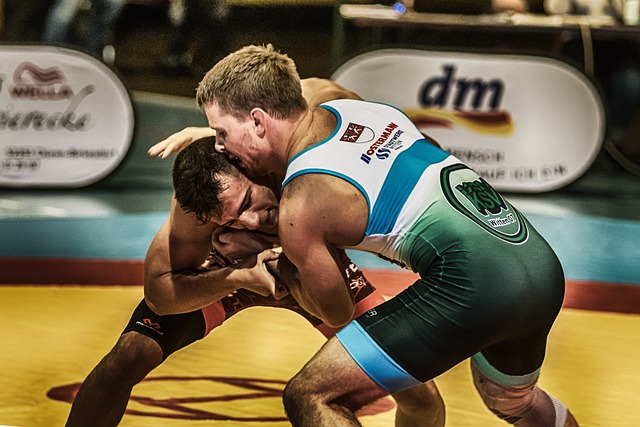Athleticism, drama, and spectacle are all used in professional wrestling to create an engaging performance. It has been a well-liked type of entertainment for more than a century and has changed significantly throughout that period. From catch wrestling to the gaudy grandeur of the modern WWE, professional wrestling has captured millions of spectators worldwide.
Professional wrestling is fundamentally a kind of performance art in which competitors use the ring to create stories with their body. The physicality is real, but the matches are staged. In order to advance the plot of their bout, wrestlers perform bone-crushing submissions, power-packed smashes, and high-flying feats while maintaining character.

The kayfabe idea, in which wrestlers maintain character at all times and spectators believe the acts in the ring to be real, is essential to professional wrestling. This method makes it possible for viewers to suspend disbelief and completely engross themselves in the characters and plots of professional wrestling.
Aside from encouraging diversity and inclusiveness, professional wrestling has made great progress in this area by accepting wrestlers of different racial backgrounds, gender identities, and sexual orientations. Differently oriented wrestlers like Kenny Omega, Sasha Banks, and The Rock have gained international recognition.
But along the years, professional wrestling has also come under fire. Some claim that the plots and characters reinforce negative stereotypes and encourage violence and toxic masculinity. Wrestlers may also take a serious physical toll; many have chronic injuries and other health issues.
In conclusion, professional wrestling blends athleticism, drama, and spectacle into a complex and multifaceted form of entertainment. Its development over time has been astounding, and people all around the globe are still drawn to it and its captivating image. Professional wrestling is still a vital and lasting aspect of popular culture, despite criticism.
The focus on narrative in professional wrestling is one of its distinguishing features. Games are more than just athletic exhibitions; they’re also a part of longer narratives and rivalries that develop throughout time. In order to develop compelling characters and storylines that keep spectators interested in their bouts, wrestlers make use of their athleticism, charisma, and microphone talents.
The audience’s part in professional wrestling is another essential component. Instead than being passive onlookers, spectators actively participate in the performance. They yell catchphrases and slogans, jeer their rivals, and applaud for their favorite wrestlers.
Only professional wrestling can foster the feeling of community and connection that is created by this degree of fan involvement.

The modern form of professional wrestling had its start in the United States in the late 1800s. Wrestling has been used as a combat sport throughout history in a variety of cultures and styles, although the present form of professional wrestling is mostly an American invention.
Nonetheless, professional wrestling has expanded to other nations, where it has created unique customs and styles of its own. For example, professional wrestling has a strong history in Japan and places a strong emphasis on technical wrestling abilities and forceful attacks, whereas lucha libre wrestling is well-known in Mexico for its colorful masks and daring actions.
Other nations outside the US that have established their own professional wrestling scenes include as follows:
- Japan: The home of New Japan Pro Wrestling and All Japan Pro Wrestling, two significant wrestling companies.
- Mexico: Well-known for its lucha libre wrestling style, which has impacted wrestling forms all around the globe.
- Canada: The origin of WWE’s NXT brand and Stampede Wrestling, as well as home to a number of well-known wrestlers including Bret Hart and Chris Jericho.
- England: The cradle of contemporary catch wrestling and the residence of William Regal and Paige, among other well-known wrestlers.
- India: The country has only lately begun to have its own professional wrestling culture, with organizations like the Indian Wrestling League and performers like The Great Khali becoming well-known worldwide.
Although the United States is regarded as the “mother country” of contemporary professional wrestling, the sport has subsequently expanded to numerous other nations, each of which has its own distinct customs and techniques.
Professional wrestling, with its own customs and techniques from different nations, has grown to become a worldwide phenomenon. While Mexico is well-known for its Lucha libre wrestling style, which has inspired wrestling styles all over the globe, Japan is home to important wrestling companies like New Japan Pro Wrestling and All Japan Pro Wrestling. Canada gave home to prominent firms like Stampede Wrestling and WWE’s NXT brand, as well as well-known wrestlers like Bret Hart and Chris Jericho.
Modern catch wrestling originated in England, which also gave rise to well-known wrestlers like William Regal and Paige. On the other hand, India has only lately begun to establish its own professional wrestling culture, with organizations like the Indian Wrestling League and superstars like The Great Khali becoming well-known worldwide.
In addition to its influence on popular culture, professional wrestling helped make a number of films, TV series, and video games. It also helped start the careers of well-known Hollywood actors like Dwayne “The Rock” Johnson and John Cena. Due to its popularity, a booming market of memorabilia and goods has emerged, with fans eager to acquire action figures, t-shirts, and other things portraying their favorite wrestlers.
Professional wrestling is facing new chances and problems in the digital era. Social media has made it simple for wrestlers to interact with fans and advertise their bouts, while internet streaming services like WWE Network and AEW Plus have made it possible for fans to watch wrestling on any device, anywhere in the globe. But with so many entertainment alternatives accessible to consumers, the development of streaming has also intensified rivalry for viewership.
Despite these difficulties, professional wrestling is nonetheless a popular kind of entertainment, catching audiences’ attention with its unique blend of athleticism, drama, and spectacle for more than a century.
With organizations like WWE claiming a market valuation of over $5 billion and collecting money from numerous sources including merchandising, ticket sales, and TV partnerships, professional wrestling has had a significant influence on the business world. A number of other wrestling firms, including Impact Wrestling, Ring of Honor, and All Elite Wrestling (AEW), have seen growth in both viewership and revenue in recent years.
Throughout its history, professional wrestling has also provided a forum for social and political criticism. Wrestlers have advocated for causes and raised awareness of significant problems using their platform. Examples of this include former WWE wrestler CM Punk’s support of LGBTQ+ rights and gun violence awareness, as well as John Cena’s outspoken support of the Make-A-Wish Foundation.
In addition to its impact on business, social concerns, and popular culture, professional wrestling has inspired and entertained millions of fans worldwide. Professional wrestling has something to offer everyone, from the intensity of WrestleMania to the drama of the Royal Rumble and the technical prowess of the G1 Climax.
In summary, professional wrestling is still a distinctive and complex kind of entertainment that has a big influence on business, social concerns, popular culture, and the lives of millions of fans worldwide—despite its shortcomings and detractors. Its impact is probably going to last for many generations.
The popularity of professional wrestling has been sustained by its constant evolution to accommodate shifting viewer tastes. Because of its widespread appeal, fans from many ethnicities and origins have come together, and the wider range of wrestlers has made the sport more welcoming to all identities. Professional wrestling continues to enthrall millions of fans worldwide with its physicality, drama, and larger-than-life characters, despite criticism.
The influence of professional wrestling on popular culture is another important factor. Since the 1980s, when wrestlers like Hulk Hogan and Randy Savage shaped the era’s design and style, it has inspired advertising, music, and fashion. Due to wrestling’s widespread appeal, wrestlers have been included in TV series and motion pictures. Examples of these include Mr. T’s role in WrestleMania and Roddy Piper’s They Live. Popular music has also been impacted by wrestling, as seen by the entrance themes of wrestlers and the use of wrestling images in rock and hip-hop songs.
wrestlers in professional wrestling
Athletes who compete in professional wrestling contests are referred to as wrestlers or performers, or professional wrestling players. These athletes have a range of experiences, including combat sports, bodybuilding, amateur wrestling, and martial arts.
Among the all-time most well-known professional wrestlers are:
The legendary wrestler Hulk Hogan rose to prominence in the 1980s and 1990s.
“Stone Cold” Steve Austin: Known for his defiant demeanor and tagline “Austin 3:16,” Austin was one of the most well-liked wrestlers of the 1990s and early 2000s.
The Rock is a third-generation professional wrestler who rose to fame in the late 1990s and early 2000s before launching a lucrative film career.
John Cena: A professional wrestler who became well-known in the 2000s and one of the most well-known figures in WWE history.
Ric Flair: Considered one of the best wrestlers of all time, Flair was a renowned competitor for many decades.
The Undertaker is a well-known and eerie figure in the WWE who has been a mainstay for more than thirty years.
A professional wrestler from the 1980s and 1990s, Bret Hart was well-known for his technical prowess and his feud with Shawn Michaels.
Shawn Michaels was a professional wrestler in the 1980s, 1990s, and 2000s who was well-known for his physical prowess and colorful demeanor.
These are just a few of the many gifted and illustrious wrestlers who have left their imprint on the business throughout the years. A lot of young, up-and-coming wrestlers are now becoming well-known in organizations like New Japan Pro Wrestling (NJPW), All Elite Wrestling (AEW), and WWE.
Is the professional wrestling business successful?
The professional wrestling business may be quite lucrative, especially for well-known firms like NJPW, AEW, and WWE. These businesses make a sizable profit from a variety of sources, including sponsorships, live events, TV partnerships, and retail sales. For example, WWE recorded $974.2 million in revenue and $77.1 million in net income in 2019. The company’s revenue sources included live events and ticket sales, product sales, streaming subscriptions, and TV relationships with networks like Fox and NBCUniversal.
Similar to this, AEW has become a lucrative and effective campaign that makes money via item sales, live events, and TV sponsorships. There have been reports that they made $43 million in their first year of business. Even if they run at a lesser level, smaller independent wrestling organizations may still turn a profit by making money from live events, gear sales, and other sources. Success is not certain in the very competitive and difficult professional wrestling business, even with its financial possibilities. However, those who can amass a devoted following and produce income via a variety of platforms might succeed in this field. Read more